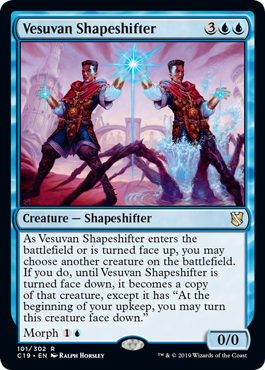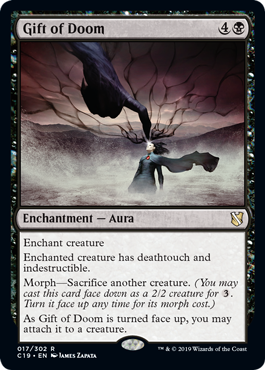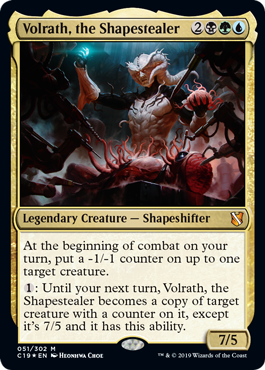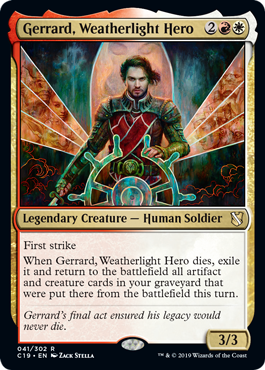Need I Say Morph
Welcome to Commander (2019 Edition) previews. All this week, we'll be sharing with you the themes of the four decks and showing off preview cards. As we've done in past years, each day is going to show off a different deck along with preview cards from that deck. I'm going to begin by walking you through the overall structure for this year's Commander 2019 decks and then talk specifically about today's featured deck and show off my preview cards—two brand-new and one reprint with new art.
What the Deck
Every year, the Commander design team comes up with a unified way to structure their decks. Sometimes it's color-based (e.g., all the decks are wedges), sometimes it's built around a theme (planeswalkers that can also be commanders), sometimes it's built around a mechanical hook (each deck has a tribal theme). For Commander (2019 Edition), the design team decided to build around popular Magic mechanics. For each deck, the team chose a mechanic and then picked the colors that best complimented that mechanic. Today's deck is a three-color deck (black-green-blue) built around the mechanic morph. Morph was originally in Onslaught block but has been brought back in Time Spiral block and Khans of Tarkir block.
I'll get to my preview cards in a moment, but first I want to tell the story of morph's origin. I've told this story before, so I thought today, I'd go into a little more detail than I have in the past. We begin our story by going back to Limited Edition (Alpha). When Richard Garfield was initially designing Magic, he was creating it to be a normal game. It's just not practical to design a game assuming it will become a breakaway phenomenon. What that meant was, original Magic was designed to be a game you played at home with your friends. As such, Richard purposefully designed some cards that were very flavorful, but a little vague. Part of the fun of exploring the environment was figuring out how some of the cards worked. To Richard, cards that spurred conversation about how exactly they functioned were features and not bugs. The assumption was each play group would talk out how they wanted it to work.
Flash forward a few years. Magic had become a breakaway phenomenon. People weren't just playing in their homes. They were coming to game stores and playing in tournaments. There was a Pro Tour and many Grand Prix and a whole tournament structure. The game couldn't just let players figure out how they wanted cards to work, there had to be hard and fast rules. This led to the creation of Classic Sixth Edition rules, which cleaned up a lot of loose ends and caused the creation of what was known as the rules team, a group of people dedicated to ironing out all the odds and ends that early Magic cards had created. As the rules needs have since shrunk, the rules are now handled simply by the rules manager (who used to oversee the rules team).
The rules team at the time (Paul Barclay, Elaine Chase, Brady Dommermuth, Jeff Donais, Mike Donais, and Collin Jackson) would meet once a week and work through a backlog of old cards that had to be brought in line with the current rules system. Two of the most nagging cards were Illusionary Mask and Camouflage, both from Alpha.
The idea behind them was a lot of fun. You would take a creature and place it face down, and as long as it was face down, the opponent didn't know what the creature was. In the early days, players would attempt to do things to the card, and the card's owner would inform them whether it worked.
"I Terror it."
"It doesn't die."
"Okay, it must be a black creature or an artifact creature. If it was untargetable, you would have had to tell me it couldn't be targeted. Now I Shatter it."
"It doesn't die."
"Not an artifact. It must be a black creature."
This was a fun game to play at home, but in a tournament setting where the opponent couldn't confirm anything that was being said, it was problematic. The rules team had worked through a backlog of troublesome cards, but Illusionary Mask and Camouflage had proven to be thorns in the rules team's side. Then, one day, they came up with an out-of-the-box solution. What if face-down cards had a defined quality? That way when they were face down, you knew what could and couldn't happen to them. Both Illusionary Mask and Camouflage would allow you to turn the creature face up so if you ever wanted to take advantage of its true nature, you could, but then you'd have to reveal publicly what the creature was. This made the cards work in a way that rules could handle.
While they were happy they'd found a solution to the two cards, the rules team was thinking bigger. This technology could be used to make a mechanic. What if there were cards with this ability built in? You could unify their mana cost so any of them could be played without giving away what they were and without creating a need for the players to know which specific card it was. It would require players revealing any face-down cards at the end of the game to prove they had the mechanic, but tournaments could handle that. As they were having this excited conversation about this new mechanic, they heard a loud voice coming from the room next door. That loud voice was me.
Now we cut to a different part of this story. Bill Rose was the head designer at the time and had asked my help with the Onslaught design that had just been turned in. While there were a lot of cool individual designs in it, Bill was concerned about the two major mechanics in the set. He asked me to spend some time thinking about how I might change it. The reason I was next door to the rules team was because I was meeting with Mike Elliott, the lead designer of Onslaught, to talk through some of my thoughts. I had this idea that it would be cool to take a tiny tribal theme that was in the set and ramp it way up, making it the main theme of the set. He and I were talking about this when Jeff Donais ran into the room.
Jeff Donais ran our Organized Play program back in the day and was part of the rules team because it was important to think through Organized Play ramifications when making rules decisions. Jeff had heard me (again, I'm pretty loud) and ran next door to tell us about the new mechanic idea the rules team had. He excitedly pitched the mechanic to us. If a card had this mechanic, you could play it face down for two mana and get a 1/1. Then, if you paid a certain cost, you could turn it face up and it would become whatever the creature naturally was. Mike was unimpressed. It seemed fiddly and not worth the bother of having face-down cards on the battlefield. I liked it, but I said to Jeff that it felt like it needed some work. I was on the hunt for a new mechanic for Onslaught and felt like morph might play well with a tribal theme, so I got together with Jeff separately to talk through the new mechanic. Jeff explained all the nuance, and I asked for a week to think it through.
During that week, I set out to make some cards with the mechanic to get a feel for what it could do. I quickly came to several conclusions:
- A 1/1 was too little. You seldom felt a need to block it, as 1 point of damage usually wasn't worth the potential blowout. Also, it was a little too easy to kill. My suggestion was to change it from a two-mana 1/1 to a three-mana 2/2.
- Just changing shape wasn't enough. I felt that the mechanic had room for more. What if some creatures also had an effect when it was turned face up? This allowed a lot more gameplay options and opened design space.
- It needed a name. A lot of selling a mechanic is giving it a sense of flavor. I called it "stealth" to begin with.
I then designed enough cards to fill two decks of different color combinations. The idea was instead of explaining the new mechanic to people, I would just have them play it. I'd learned over the years that the best way to get people excited by a new idea was to let them experience the fun of the thing while playing it. Little by little, I played the decks with all of R&D and slowly built some consensus. Bill, who'd been skeptical of the initial pitch from the rules team, enjoyed the gameplay and signed on to having it be one of the mechanics in Onslaught. To give the mechanic some room to grow over the block (and to help with the creature-only Legions design), we purposely held back the "spell" morphs for the second set. And that was how morph came to be.
With that out of the way, it's time for my preview cards. We'll start with the reprint (with new art).
Click here to see it

Vesuvan Shapeshifter came about when we brought back morph in Time Spiral. The set was about the past, so I suggested a rare cycle where each morph creature turned into a facsimile of a famous creature from Magic's past. The key to the cycle was finding cards that had a cool interaction with morph. I think we started with Clone because that seemed like a neat effect to combine with morph. What is my face-down creature? A copy of anything already on the battlefield. But Clone didn't feel grandiose enough for this cycle, so we went back to Alpha and looked at the one other creature-copying card, Vesuvan Doppelganger.
The first problem we ran into was that the text didn't fit. Vesuvan Doppelganger already had a wordy text box, and adding morph wasn't helping. (Because it's a rare, we were allowed to drop the reminder text.) Then it occurred to us that we could take advantage of the fact that the card had morph to replicate the Vesuvan Doppelganger's ability to change who it's copying. Instead of adding text that did it, we just allowed it to have shorter text that let you turn the creature face down if you wished. Turning it face up would create a similar effect to copying a new creature.
The second problem we ran into was that the card didn't quite work the way we hoped it would. There were a number of morph cards that generated an effect when turned face up, and we wanted Vesuvan Shapeshifter to be able to get those effects if it copied a face-up morph creature.
Luckily, the rules manager at the time, Mark Gottlieb, was able to figure out a way to add a rule to allow it. I'm happy Commander 2019 was able to bring the card back for more players to discover.
Next is a brand-new card, one with a tweak to morph that I tried and failed to get into the game for a long time.
Click here to see Gift of Doom

Longtime readers of Making Magic might remember this as "auramorph," a morph variant we considered for Dragons of Tarkir. The Khans of Tarkir block had a time-travel story where Sarkhan Vol went back in time and saved Ugin from dying in a battle with Nicol Bolas. In doing so, he changes the timeline so that Tarkir, instead of being run by the khans, is now run by the dragons (the dragons had been killed off in the original timeline). To represent this mechanically, we had morph in Khans of Tarkir, manifest (as a proto-morph) in Fate Reforged, and megamorph (as a morph variant) in Dragons of Tarkir. In exploratory design for Khans of Tarkir block (back then, we did the exploratory design for all the sets in a block at once), we experimented with a number of different morph variants. Auramorph, Auras with morph, was the version we'd walked out of exploratory design expecting to use.
When we got to design for Dragons of Tarkir (this predates vision design being a thing), playtesting showed that auramorph didn't work well if it was what all the morph creatures in the set were, so it wasn't used as the morph variant for the set. (Looking back, while I agree auramorph wasn't correct, I do wish I'd pushed harder for "smorph"—a morph variant where you payed four for a face-down 2/2 that came with a +1/+1 counter.) While looking for new morph designs for the morph Commander (2019 Edition) deck, the team decided to revisit some of the design space from earlier explorations. Auramorph didn't work well in a vacuum but was fun when mixed in with normal morph creatures. My best guess was this was put in black because blue and green have more morph tweaks, as they were the two colors of the Draft archetype in Time Spiral and Khans of Tarkir blocks.
Now we arrive at the preview card I'm most excited to show off. It's a character I co-created many years ago.
Click here to see my final preview card

When Michael Ryan and I created the Weatherlight Saga, we knew we needed a good villain, so we studied what we needed to do to make that happen. One of the important things was that the hero and the villain needed to have a relationship. We decided to make them adopted brothers and to build into the story a reason why Volrath (then Vuel) hated Gerrard. (Vuel blamed Gerrard for causing him to fail the test that would have set him up to eventually become leader of his people, following in the footsteps of his father, Sidar Kondo.) We also needed for him to have some cool abilities. To make our story work, we chose to make him a shapeshifter. This would allow him to board the Weatherlight under the guise of being someone else. (The Weatherlight story changed significantly after Michael and I left it, so the story veered a bit from our original version.) We also wanted him to have an interesting hobby to give him some depth as a character. We decided that he was obsessed with zoology and fascinated by all the various creatures of the Multiverse. (Back then, non-Planeswalkers had some access to move between Planes with things like portals.) It was this obsession with creatures that caused him to bring the Slivers from their home Plane to Rath, so he could study them.
When it came time to make a card for Volrath (in Nemesis—the character was being killed off so this was the last chance to do it), we were restricted to a single color because the next block was going to be Invasion and it had a major multicolor theme, so we were starving players of gold cards. (We've since moved away from that theory and now have a low but constant stream of multicolor cards in most sets.) As the focus on Volrath was his villainous nature, I felt like the card had to be black. Looking back, I think if I had to pick one color it should probably have been blue. He's a shapeshifter obsessed with a subset of knowledge. He's sneaky and underhanded. He's a blue-black character, but probably more blue than black. Nonetheless, I chose to make him mono-black and I needed to capture his main ability, shapeshifting, so I made a quirky card that let me do it in a black way.
Looking back, I was never very happy with Volrath's card. I adored him as a character, and I never felt he got a card that really captured him. So, I was excited by the news from Glenn Jones, Commander 2019's lead set designer, that he was making a new Volrath. Just one thing—the card needed to be three colors because he wanted it to be usable as a commander for the deck. Would black-green-blue work for the character? I said he was in luck. Volrath was clearly core blue-black, but if you had to add on a third color, green made a lot of sense. Volrath had a number of Simic qualities in his desire to not just observe but experiment on living things, trying to "improve" them. If I had to pick a third color for Volrath, it would be green.
For fans of the Weatherlight Saga, I have some good news. Commander (2019 Edition) includes not one, but four Weatherlight Saga characters with new cards. One, which we previewed yesterday at Gen Con, is Gerrard, Volrath's nemesis.

Gerrard, even more so than Volrath, deserved a better card, and I'm happy he was finally able to get one. I don't want to give away who the other two characters are, but I will say both have previously had cards.
The Morph You Know
That's all the time I have for today. I hope you're excited to see the new decks and play with the new cards. As I said up top, check in each day this week (for the next three days) to learn about each of the other Commander (2019 Edition) decks and see more preview cards. As always, if you have thoughts on today's column, including things on Commander 2019, morph, auramorph, Volrath, or anything else I've discussed here, please feel free to email me or contact me through any of my social media accounts (Twitter, Tumblr, and Instagram).
Join me next week for a look into thematic parties.
Until then, may you enchant Gift of Doom on your Vesuvan Shapeshifter copying Volrath, the Shapestealer.
#659: Modern Horizons Cards, Part 1
#659: Modern Horizons Cards, Part 1
47:30
This is part one of a four-part series on card-by-card design stories from Modern Horizons.
#660: Modern Horizons Cards, Part 2
#660: Modern Horizons Cards, Part 2
40:47
This is part two of a four-part series on card-by-card design stories from Modern Horizons.
- Episode 658 Split Cards
- Episode 657 Innovation Products
- Episode 656 Modern Horizons

